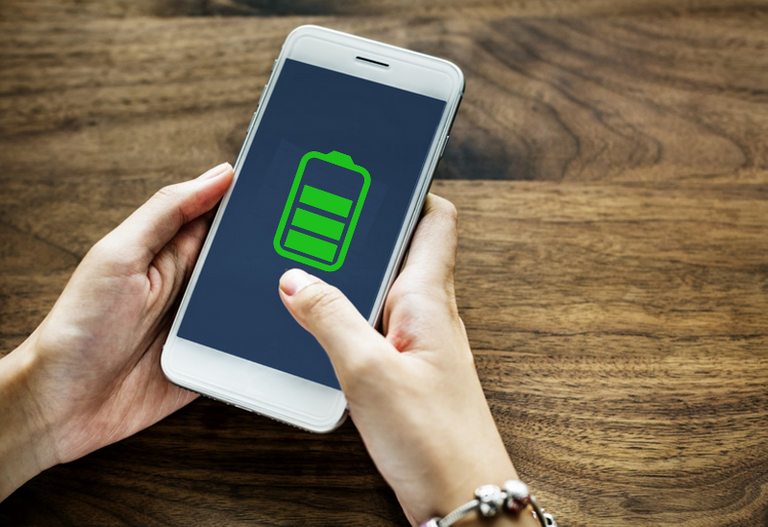Thermoelectricity. Convert body heat into electricity
Something that could sound very science fiction is already in the sights of many researchers, it is thermoelectricity, the ability of some materials to produce electricity by taking advantage of the heat released by a body, a machine or by some process where a work, can you imagine that in the future we can charge our cell phone simply by carrying it close to the body? It would be a really interesting way to get renewable energy, since heat is very abundant.

Maybe in the future we will be able to charge the cell phone just by carrying it close to the body. Source: Edited image, original from pxhere.com.
Although we are still far from achieving something like this in principle if it is possible, thermoelectricity is any way of converting heat into electrical energy, a process that is nothing new since in the past we have used heat to generate steam, and that then that steam was used to move the turbines that, when connected to a generator, transformed the mechanical energy into electrical energy. However, when we refer to thermoelectricity in electronic devices, we are referring to thermoelectric phenomena observed in materials.
For example, when two different metals that are in contact through a bimetallic bond are subjected to different temperatures, an electromotive force is produced between both sides of the bimetallic bond, a phenomenon called the Seebeck effect. Through this effect, when applying heat to said bimetallic joint, the charge carriers of the materials move from the end that receives heat to the cold end, generating an accumulation of charge in the cold end of each one, which makes between those extremes generate a potential difference, called thermovoltage, and that is produced proportionally to the difference in temperature applied between the hot and cold extremes.

Diagram of the thermoelectric effect. Source: Wikipedia.com.
This possibility of using a flow of heat in electric current has made it possible to develop important electrical generation applications, such as the system used to generate electricity used by the Voyager space probes, which use a radioisotope thermoelectric generator, where the flow of heat it is established by PuO2, which is radioactive, and when it disintegrates it provides a source of heat, and by means of a silicon and germanium thermocouple the electricity that the probes need is generated, since they cannot be powered by solar panels in deep space.
And although different metals and inorganic semiconductors have been used for these applications, organic semiconductors have emerged as a promising material system due to their mechanical flexibility, light weight and low thermal conductivity, thus attracting interest for their use in the field of flexible thermoelectric.
In this sense, researchers from the Technical University of Dresden have revealed a new way to achieve superior organic thermoelectric devices, through a technique called modulation doping, which allowed them to investigate the charge and thermoelectric transport in thin films of rubrene of large surface area doped by modulation with different crystalline phases. The results have been published in the journal "Science Advances".
This efficient doping for the creation of charge carriers has been fundamental for the development of semiconductor technology, and organic semiconductors have aroused great interest for their application in the development of flexible and more environmentally friendly electronic articles. According to the researchers, conventional doping usually introduces disorder at high doping concentrations, but the modulation doping method has allowed them to obtain highly ordered organic thin films, allowing them to achieve high doping densities without limiting charge transport at through thin films. Doping refers to the process of intentionally adding impurities to a semiconductor to modify its properties.

Example of silicon doping by phosphorus. Source: Wikipedia.com.
The results showed high thermoelectric power factors with modulation-doped orthorhombic rubrene crystals, which has allowed them to demonstrate that modulation doping, together with crystalline organic semiconductors, are an excellent combination to achieve organic thermoelectric materials with higher performance to collect. energy from heat sources.
Although this work does not provide us with a way to obtain electricity through body heat, it opens the door to research in this area to obtain flexible thermoelectric devices that can generate electrical energy from heat more efficiently, promoting other research in the area of organic thermoelectric materials that have that focus, and in the future we may see clothing that collects heat from the body and transforms it into electricity; or devices that supply electricity from heat sources such as vehicle exhaust or fireplaces.
Thanks for coming by to read friends, I hope you liked the information. See you next time.
Great Post!
!1UP
You have received a 1UP from @luizeba!
@stem-curatorAnd they will bring !PIZZA 🍕
Learn more about our delegation service to earn daily rewards. Join the family on Discord.
Many thanks!
PIZZA Holders sent $PIZZA tips in this post's comments:
@curation-cartel(17/20) tipped @emiliomoron (x1)
Please vote for pizza.witness!
Thanks!